Coahuilan Box Turtle
Tortuga de Bisagra
Terrapene coahuila
Return to Organisms/ Regresar a Organismos
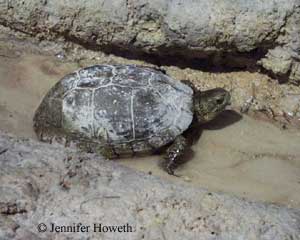
Terrapene coahuila (Testudines, Emydidae), an endemic turtle of Cuatrociénegas, is recognized internationally for its unusual life-history -- it is the only extant aquatic box turtle. According to recent phylogentic analyses, T. coahuila may be most closely related to T. carolina, indicating that T. coahuila's obligate aquatic lifestyle may not be ancestral to the genus, as previously thought, but rather independently evolved in response to the desert-spring ecosystem of Cuatrociénegas (Feldman and Parham 2002, Stephens and Wiens 2003) . Terrapene coahuila's geographic range consists of disjunct populations covering less than 800 km^2 in the intermontane valley (Brown 1974). Data collected from 1964-1967 revealed that population densities ranged from 133-156 individuals/ha in certain locales. The turtle primarily inhabits shallow grassy marshes in Cuatrocienegas, and within these aquatic environments is an opportunistic forager of insects (50.7%) and plants (45.7%; Brown 1974). Brown (1974) estimated that an individual's home range diameter was 25.6 m. However, individuals may deviate from this home range, and cross the desert floor during the rainy seasons of late spring, summer, and early fall (Webb 1963; Brown 1974). Most marked turtles in Brown's investigation remained within a marsh for a relatively long period of time (7-11 months), but 20% of recaptured turtles moved to different aquatic habitats. Details of T. coahuila's breeding season, nesting sites, and juvenile's habitat preferences remain unknown.
Conservation
Terrapene coahuila is listed as endangered, CITES Appendix 1, and is on the conservation priority list of the World Wildlife Fund and the Turtle Conservation Fund (2002). Recent surveys of T. coahuila's geographic range boundaries indicate that the species range has collapsed over time, primarily moving inward from the north-east towards the core (Howeth, unpublished data). Loss of T. coahuila habitat is occurring at a dramatic rate due to local agricultural practices, including traditional canal irrigation and the farming of cash crops such as alfalfa. Continual wetland desiccation will likely result in an ongoing trend of range contraction via the extirpation of peripheral populations, and may ultimately lead to the extinction of the species. The data from the current study may be used to aid efforts in conserving sources of morphological and potential genetic diversity that are under the great threat of extinction.
Monitoring
Starting in 2002, there were two turtle marking systems adopted for monitoring Terapene coahuila. One system, mollusc tagging, was implemented to facilitate identification of the turtles by Cuatrocienegas residents and ejiditarios. These silver tags (©Floytag) use an alphanumeric identification system, and are glued to a right pleural scute (Figure 1). This marking system is temporary (lasting 2+ years), but effectively encourages turtle tracking by the locals. The other system, scute-notching, uses files to make permanent marginal scute notches that represent a four digit number, and which coincides with the mollusc tags. From a dorsal view, the turtle is divided into quadrants. The first quadrant represents the thousandths digit, the second the hundredths, the third the tenths, the last, to the left of the head, the ones place (Figure 2, 3).
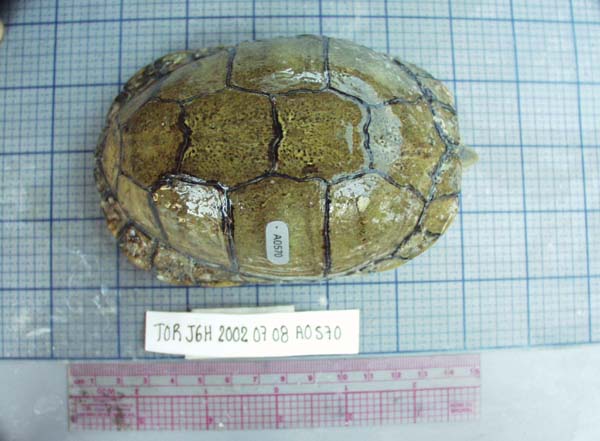
Figure 1. Terrapene coahuila marked with a mollusc tag on the right pleural scute.
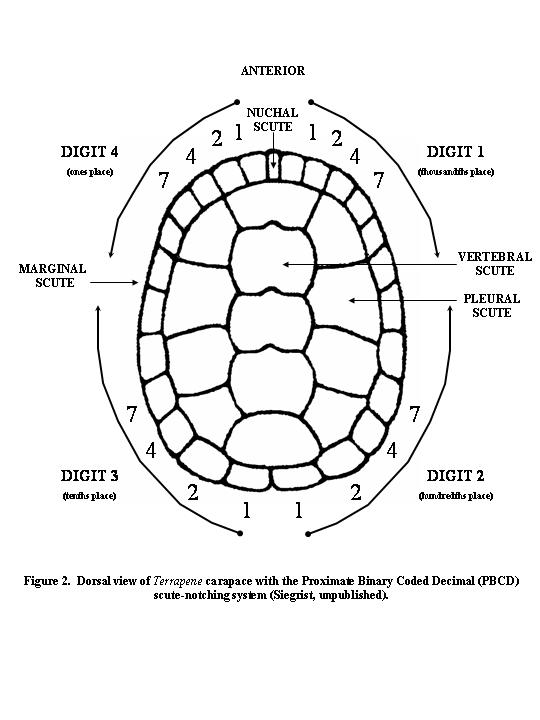
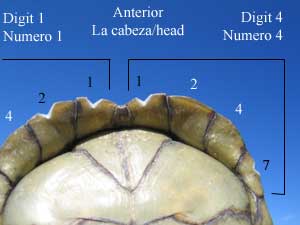
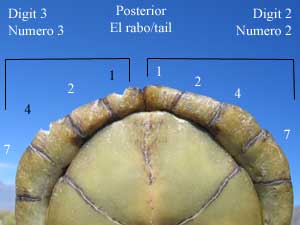
Figure 3. Terrapene coahuila marked with the Proximate
Binary Coded Decimal scute-notching system.
This turtle is marked as "3058." Digit 1 is 1+2=3, digit 2
is 0, digit 3 is 1+4=5, digit 4 is 1+7=8. Note that this is the ventral
(plastral) view of the turtle, while the diagram above is the dorsal (carapacial)
view.
More about the marking system:
We realize that our system is not a true binary numbering system as some think must have been our intent. A binary numeral system would have the value double for every scute, so that the values would be 1,2,4,8, 16,32,64,128, ... up to 32768 for the last of 16 notchable scutes. The notching sytem is really a base-10 positional system, but each digit is coded as a binary number. The four quadrants of the turtle give the four digits, with the ones place, the tens place, the hundreds place and the thousands place. We use 7 instead of 8 for the last scute in each set of four notchable scutes because one only needs to code 0 through 9 for each digit, where 0 is represented by no notch. Our system thus requires filing at most two notches for each digit. If 8 were used instead, then three nothes are required to represent the number 7. Filing is somewhat laborious and slow in the field. Because 8 is not required to represent the numbers 0-9, using 7 instead saves a lot of effort. It is still a binary system for representing each digit, because you just use two symbols (notch or no notch) to represent each number, but because we didn't use the standard sequence, we called it "proximate" binary. Additionally, since we started at 1000, we didn't need to distinguish between 1, 10, 100, and 1000. The system them goes from 1000 to 9999 with two notches per digit, but could go up to 14999 by notching all the scutes in the thousands place. So, in summary, we used this binary-coded decimal system as opposed to a purely binary system because it is easier to read in the field and uses less notches for many numbers. Reading the numbers just involves adding numbers that sum to 0 to 9, instead of, for example, 32768+64+32+16.Literature Cited
Brown, W.S. 1974. Ecology of the aquatic box turtle, Terrapene coahuila (Chelonia, Emydidae) with comments on its evolutionary status. Bulletin Florida State Museum 19(1): 1-67.
Feldman, C.R. and J.F. Parham. 2002. Molecular phylogenetics of emydine turtles: taxonomic revision and the evolution of shell kinesis. Molecular Phylogenetics and Evolution 22(3): 388-398.
Stephens, P.R. and J.J. Wiens. 2003. Ecological diversification and phylogeny of emydid turtles. Biological Journal of the Linnean Society 79: 557-610.
Turtle Conservation Fund. 2002. A Global Action Plan for Conservation of Tortoises and Freshwater Turtles: Strategy and Funding Prospectus 2002-2007. Washington D.C.: Conservation International and Chelonian Research Foundation, 30pp.
Webb, R.G., W.L. Minckley, and J.E. Craddock. 1963. Remarks on the Cohuilan Box Turtle, Terrapene coahuila (Testudines, Emydidae). Southwestern Naturalist 8(2): 89-90.
Other Relevant Resources:
Abell, R.A., D.M. Olson, E. Dinerstein, P.T. Hurley, J.T. Diggs, W. Eichbaum, S. Walters, W. Wettengel, T. Allnutt, C.J. Loucks, and P. Hedao. 2002. Freshwater Ecoregions of North America: a conservation assessment. Island Press, Washington, D.C.
Brown, W.S. 1967. Natural history of Terrapene coahuila, a relict aquatic box turtle in northern Mexico. Master's Thesis. Arizona State University, Tempe, USA.
Brown, W.S. 1971. Morphometrics of Terrapene coahuila (Chelonia, Emydidae), in Northern Mexico. Southwestern Naturalist 16(2): 171-184.
Dodd, C.K. 2001. North American Box Turtles: a natural history. University of Oklahoma Press, Norman, Oklahoma.
Milstead, W.M. Relict species of the Chihuahuan Desert. Southwestern Naturalist 5(2): 75-88.
Milstead, W.M. 1967. Fossil box turtles (Terrapene) from central North America, and box turtles of eastern Mexico. Copeia 1967(2): 168-179.
Williams, K.L. 1960. Captive box turtles, Terrapene coahuila. Herpetologica 16(2): 1-2.
For more information about current Terrapene coahuila research contact the Centro de Investigación Científica de Cuatrociénegas.
Terrapene coahuila conservation efforts are funded in part by The Nature
Conservancy and the Chelonian Research Foundation.